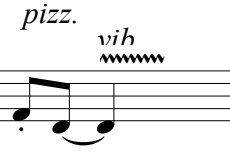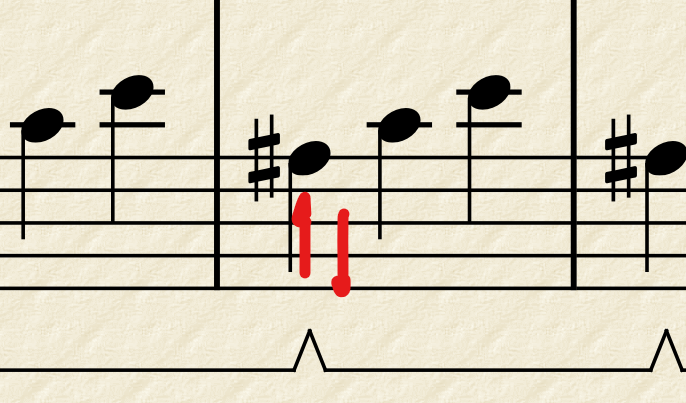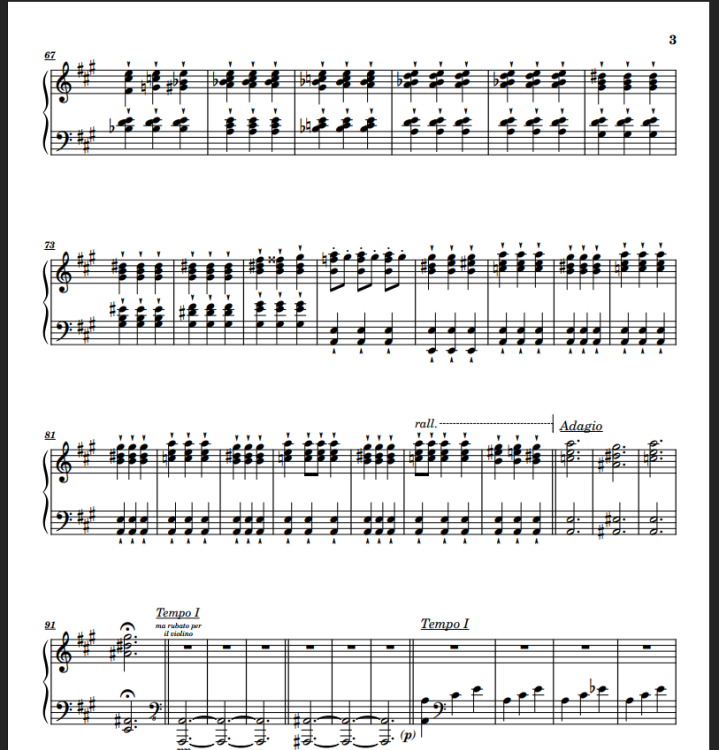Leaderboard
Popular Content
Showing content with the highest reputation on 10/28/2025 in all areas
-
Entry: Piano quintet in G sharp minor Review: The metrical stress of the composition switches between pattern 2, 3, and 5. The meter in the composition are 4/8. 3/4, 6/8, and 5/4/. These meters have different stress pattern and feel different. It would wise to either stay the 8th is division: 4/8, 6/8, and 5/8 or switch to 2/4. 3/4, and 5/4. Furthermore, it is hard to know where half point of each measure is. In some measures, there are two 8th notes rests that can easily be a quarter rest, or two 16th rest that should be 8th rest. That would make easier to read in the piano part. In rehearsal H: you are implying both 2/4 and 4/8. It is hard to know what meter you are using. I could not follow that section... Overall, in both score presentation and playability this will be score 6 for the reasons explained. The overall landscape of the piece was polyphonic, and it used atonal methods: possibly set class and others(?). This will be score be 9 The execution of a sonata form Exposition-Dev-Recap was well done. 10 There were well crafted themes, motives, and melodic materials 10 (also for creativity). This entry meet requirements of competition 10. It was done well 10 Melodies Themes Motives Harmony Chords Textures Form Development Structure Time Originality Creativity Score Presentation Instrumentation Orchestration Playability Execution of Given Challenge Taste 10 9 10 10 6 6 10 10 Average score: 8.8 Above Average/Good3 points
-
Hi Tristan. I'll try to be brief: your material is decent. I'm not puttin' grades in this informal competition but some variations here are not of my taste and would not pass. Others, maybe. I am not sure myself, for 4 hands at least. Passages like these seem very difficult to get right for one hand only: , had it been a B natural I would see it more feasible but with the speed demanded and the time you are required to sustain it, well I agree with MK's point: performers would ask you to change stuff right away or pass it off. If this is what you truly like though, don't hesitate to follow your path but be aware of the shortcomings when it comes to publish. Where is variation 12? Is the one that began at M248 perhaps? The score seems to go from 11 to 13 "Alla de Var. 12" but I don't see the Var. 12 marked. If it's that one, it's among my favourites along Var. 8. Regarding the engraving, the score is pretty much unrevised as likely 90% of scores submitted to musescore so no biggie, just another day in the job. Standard. Since it's not very heavy on content off-staff there are not overlaps (or I didn't detect any in a superficial analysis) and that's definitely a good thing. With this piece, in summary, I did like some things, disliked some others... So it ended up being about even, except for the final. Thank you for your submission, Tristan. Keep composing! Kind regards, Daniel–Ø.3 points
-
Welcome to the forums! You can comment anywhere you want as long as you follow the rules which are basically common sense (welp I didn't read them but they're probably not so strict)! Regards!3 points
-
I must confess, that with enough time, it could be possible for myself or peers to sit down and play this. However, mainly because myself and my friends are high-in-skill concert pianist's capable of complex repertoire. My logos in thinking comes from the idea of the music being "theoretical" or "practical". In my opinion, practical music is a lot stronger than "theoretical" music. While on surface level/ on paper, this score seems possible in theory. This does not mean it is the most practical or effective way to write the music. You have to keep in mind the type of performer capable of playing this. Humans need time to move the hand, their fingers, turn the page, and more. A high schooler or middle school pianist will not be able to play this unless they have had extensive training. Even I hesitate to pick it up because simply be looking at the music, and comparing it to all the music I have played, I can tell it will be uncomfortable to play in certain spots. If I were to give this to my mentor, who is a student descendent of Chopin, he would never play 4 note tremelos, only 3 notes long and switch. On the trill variation (no.3) he, and myself, would only play the trills as mordends versus proper quarter note trills. This said, challenging music is okay to make, as you can't write music to conform to everyone. Two things can be true at once, and while it may be a challenge to play, it is also uncomfortable for the average pianist. To end, your ideas are good/ fine, and I don't mean to say this piece has no merit. Instead, if you were to ask 3 musicians to sit and play this, they would have a tough time and may ask you if changes in their part would be okay.3 points
-
Hii, I had to say I really like this submission! It's so very fitting of the actual theme of halloween as a festival, reminds me a lot of dungeon synth genre and pixel art video game music. I love how the melodies intertwine and there is a constant flow that's being developed as well as the factural changes (from 1 instrument to many). I can definitely hear this going on in the background of a halloween party, keep it up! ^^2 points
-
SPANISH VERSION Hola Sebastián. Te contesto en español y luego lo traduciré al inglés todo para que la gente lo pueda leer. En general aquí hablamos en inglés pero no te preocupes, no es problema dedicar un par de líneas en el idioma de Cervantes a tu pieza. Es una pieza que no me ha disgustado para nada. De hecho, teniendo en cuenta que has usado los sonidos del general midi no suena tan mal. La idea se entiende. La ejecución de la idea ya es otro cantar. Me he fijado en esto: Imagino que a menos que el gliss. termine arco arriba el pizzicato instantáneo está complicado de hacer. Puede comportar una dificultad innecesaria, pero si a ti te gusta como está no hay más que hablar. La pieza en sí no abandona la disonancia pero tampoco se va tan lejos como para provocarme aversión o disgusto. Generas una atmósfera de suspense que con instrumentos de verdad o con mejores sonidos (soundfonts mejores o usando librerías) estoy seguro de que funcionaría muy bien. El final, sin embargo, no me convence, pero en este caso no sé si atribuirlo a la pieza o al sonido, que no ha permanecido todo el tiempo necesario para dejar la tensión suspensiva que has creado el tiempo suficiente. Viendo la partitura diría que es lo segundo. En referencia a la partitura en sí, menudos márgenes! Yo soy muy de ajustarlos mucho, pero creo que incluso para alguien que no esté de acuerdo conmigo y prefiera márgenes más anchos, diría que te has pasado. Puedes aprovechar mucho mejor el espacio y aún manteniendo márgenes grandes, hacer también más grandes los pentagramas y facilitar la lectura. No sé qué programa de composición usas, ¿quizá una versión antigua de Sibelius?. Si no te importa comentármelo a lo mejor podemos entender qué ha pasado aquí, por ejemplo: Estos son solapamientos extraños que no he visto en versiones modernas de este tipo de software, pero vete tú a saber. Haces un uso extensivo (que no abusivo) de los matices, cosa que es inteligente siempre y cuando se haga correctamente. Lo tienes todo bastante bien marcado y de no ser por los márgenes tan anchos yo creo que la maquetación te habría quedado bastante bien (que no está mal, es mejorable. Hay cada cosa...). La pieza, según el midi, dura 2:59, que en interpretación real yo creo que llega a los 3 minutos fácil, ✅. Lo que te dicen los demás usuarios del foro no va desencaminado en mi opinión. Creo que a tu motivo le quedan kilómetros por recorrer. No me extiendo más! Muchas gracias por participar Sebastián, ojalá sigas componiendo (y pasándote por aquí 😀). Un saludo, Daniel–Ø. Ø ENGLISH VERSION Hi Sebastián. I’m replying in Spanish first and then I’ll translate everything into English so everyone can read it. We generally speak English here, but don’t worry—it’s no problem dedicating a couple of lines in the language of Cervantes to your piece. It’s a piece that I didn’t dislike at all. In fact, considering you’ve used General MIDI sounds, it really doesn’t sound bad. The musical idea comes through clearly. The execution of that idea is another story, though. I noticed this: (First IMG) I imagine that unless the glissando ends with the bow moving upwards, an instant pizzicato is quite tricky to execute. It could create unnecessary difficulty, but if you like it as it is, that’s totally valid. The piece itself doesn’t abandon dissonance, but it doesn’t go so far as to provoke aversion or discomfort. You manage to create an atmosphere of suspense that, with real instruments or better sounds (using improved soundfonts or libraries), I’m sure would work really well! The ending, however, doesn’t quite convince me. But in this case, I’m not sure if it’s the piece itself or just the sound, which didn’t sustain the tension you created for long enough. Looking at the score, I’d say it’s probably the latter. As for the score margins… wow, those are wide! Personally, I like to make margins tight, but even for someone who prefers wider margins, I think you may have overdone it a bit. You could make much better use of space, and even with big margins, you could enlarge the staves and make reading easier. I’m curious...What notation software do you use? Maybe an old version of Sibelius? If you don’t mind sharing, maybe we could figure out what happened (Second image). These are some strange overlaps I haven’t seen in modern versions of this kind of software, but who knows. You make extensive (but not excessive) use of dynamics, which is smart as long as it’s done properly. You’ve marked everything fairly clearly, and if not for the wide margins, I think your layout would have turned out quite well (and it’s not bad as it is, it just could be improved). According to the MIDI, the piece lasts 2:59, which I think would easily reach three minutes in real performance. What the other forum users say is pretty much on point in my opinion. I think your main motif still has a lot of potential for development. I’ll stop here! Thank you very much for sharing, Sebastián—I hope you keep composing (and dropping by here). Best regards, Daniel–Ø.2 points
-
@therealAJGS I attached it here. Woodwind Quintet No. 1.mp3 I hope you do not mind, @Maxthemusicenthusiast! If this had any bossa feeling, you made sure to change it completely. One can still perceive the rhythm but it's something utterly different. Hi Max, and welcome to the forums! Interesting notation here: I am not too used to it and I myself don't use it, but it's cool and convenient for some and I totally understand why! I agree with @Thatguy v2.0, first part of the piece seemed like a prelude and I liked it despite of the MIDI sound (that doesn't actually bother me because of videogames I played in the past, I believe). I also agree that the fast part ends a bit too soon to my taste, but you created a very nice theme, really I think you found some gold combining the slowed down bossa nova rhythm with these dissonant passages. You take your time and don't go farther away, which I like, as sometimes we are tempted to break rules in all directions due to having broken some on a single one. I am glad you did not do that, consciously or not. You make good use of dynamics, articulations, and your writing contains nothing incredibly difficult. This piece you submitted suggests me you do know your craft, you did not rush the end, and I feel balance when I listen to your piece over and over again. It doesn't sound very Halloween-ish to me, though, but it doesn't really need to. The work is sober, but solid, and it does a good job by portraying some indeed sinister place in my honest opinion. It does transmit uneasiness to me, but at the same time, it doesn't let me go far away and keeps me there, uneasy, but enjoying nonetheless. Shall I repeat again, the ending did convince me. Very good job. Thank you for your submission, I hope you stay around! Kind regards, Daniel–Ø.2 points
-
Hi, HoYin Cheung! Bear with me for a small while this time. Couldn't resist to quote this, I think it's a very good way to define the difficulty of some parts of this score. It doesn't seem to be an easy feat for neither the strings nor the pianist (perhaps the pianist has less trouble than the violin though!). I am in partial agreement with @MK_Piano here. I do appreciate the atmosphere you created in some parts (the piano solo w/pedal part for example), but after a couple of listenings, and while being true that "I wouldn't mind listening to it again" (and so I did, many times already), there is essentially nothing that makes or would make me gravitate towards this piece enough to listen to it much longer. At this point, I may have heard hundreds of these pieces, part here at YC or other forums such as free-scores, part LIVE, and while I honestly think you did a good job with the score and you probably took a while to write all of this... Truth is, that after the less and less likely initial surprise/shock it went directly to the same far away place in my mind that I am no longer curious to explore or remember. It just melt, liquid; fused with an immeasurable and diffuse blob of notes, clusters and dissonances that are all different yet they feel the very same and which time has taught me to withstand but never to enjoy. Truth is, I very rarely enjoy "contemporary" pieces of this kind, more of a mesh of dissonances stained with interesting material than anything else. They almost always simply "go through", and this one was sadly no exception. However, I would say the ending of this piece was ok, which is five to ten orders of magnitude better than what I usually think of ending sections/passages/bars of pieces that more weakly or strongly (I guess that's again subjective) resemble your piece. And as a rule of thumb with all pieces that come with a description first, I tend to have a listen or two before I read it. Now it would be impossible to me to tell you if reading it beforehand would have influenced me enough to be in agreement with what you claim to portray with your piece, but by having done the opposite process I can guarantee you that from my humble and maybe very wrong opinion (not only because I am not familiarised with Gaelic culture but because I am familiarised with the particular sound of this particular style of contemporary music) this piece did not evoke anything related with the story, not any more than other pieces or parts in pieces like...Dunno: • String Quartet No.1 - Javier Torres Maldonado • Ligeti: String quartet No.2 - Arditti quartet. Just in case, I am not sure if these are composers of reference (they ain't very famous but they ain't precisely unknown either) or that they do mimic your work, this is not what I tried to convey here. Finally and despite my not very benvolent words I would still judge your piece at least one or two orders of magnitude above any section of these two examples I have provided had they been brought to this informal cozy contest, so they may not do justice to the work of yours. All in all, thank you for your submission! Best regards, Daniel–Ø.2 points
-
Hi again man, it's me, the long reply guy again! But this time I'm having a look at your quartet :). How important structure is. If there's anything I love listening to that would be 100 of 100 times how apparently simple stuff gets way stronger than what one can anticipate making intelligent use of structure. What first felt like a nice but not specially remarkable rhythm and material, later came back strengthened. It's something that our grand masters of the past knew very well and I personally never get tired of it. This is a very solid and aesthetically beautiful (in my humble opinion) quartet which although it doesn't stand out for doing anything revolutionary, it definitely doesn't need to! It handles very well the essential elements that make it up, and if this weren't an informal competition and I were to evaluate it seriously, it would be among the best pieces submitted these days. We have different tastes when it comes to engraving (I am not into rehearsal marks with bar numbers or big tempo indications, but I very much understand their usefulness). That aside, your score is very well engraved, again in my opinion. Congratulations and thank you for your great submission. Best of luck and...Hope you stay around! Kind regards, Daniel–Ø.2 points
-
Welp man, this is a full horror medley. Very cool ending, nothing to complain about, maybe some automatic overlaps in the score here and there but these are tiny details and it's not like I spotted many. You fully captured the feeling, that's undeniable. And the more I listen to it, the more seamless it feels and the more coherent its parts become together. Nicely used harmonics in the "B part". this ain't just "here you go, some effects" and call it a day. It's a very difficult (or so it seems) but solid scary dissonant quartet. My favourite part is this somewhat cantabile melancholic melody you manage to do in the middle of this dissonance of a quartet (in the good way) that leads again to a B' (because of the triplets). And let me mention again, the ending is very solid, very cool. I don't quite get the title, so it's a 4/10, sorry... 🤑 I'll vote for you Kind regards!!2 points
-
Hi again man. I took note of all your comments (and @Kvothe's) and prepared a second edition featuring a score pretty much like I saw it in your examples. System dividers + rehearsal marks have been added. The other parts are reduced. I maintained my usual engraving style but added most of what you mentioned in the Piano+ part. I didn't abuse of rehearsal marks because they were on top of the already present measure numbers. Best regards!2 points
-
Entry: Bagatelle Nº6 @MK_Piano has mentioned wider margins around the score would give the score a polish look. Only a half point taken away, in score presentation for that. In the violin part, you want provide the player time from pizz to arco and vice versa. They will thank you for this! In the opening section, where the piano descends, it might sound to muggy with the sustain being held down that long. Also, it is probably wise to pedal down beat in 3/4. (just a thought). Thus, this will be score an 8. The execution of the challenge was meet it was within the time frame. It was scored for the correct ensemble. 10 The piece was original and creative. 10 The textures of the pieces were homophonic but yet there was polyphonic textures: everything came to together. 10 Overall the piece has melodic and motivic material and form that flows naturally and logically: 10 Average score: 9.6 very good Melodies Themes Motives Harmony Chords Textures Form Development Structure Time Originality Creativity Score Presentation Instrumentation Orchestration Playability Execution of Given Challenge Taste 10 10 10 10 9.5 8 10 9.52 points
-
2 points
-
Hi, I'm new so not sure if I'm supposed to comment here, but I wanted to say I'm amazed by this work. Really impressed with the natural dramaturgy of music flow as well as usage of contemporary harmony, rhythm, melodies. Glad to hear something new and exciting like this, keep it up ^^2 points
-
@Omicronrg9 That was a long reply, so I may just focus on one aspect versus all of it lol. In all of the accompaniment work and chamber playing I have done, I would say most, if not all, of the scores had smaller staves for non-piano parts. I will attach a collection of links from IMSLP showcasing Piano trios from Mozart and Beethoven. Both Henle-Verlag and Bärenreiter-Verlag use reduced staves. Since smaller works do not need a conductor, the pianist usually gets the full transposed score. Allows us to follow along and coordinate with the musicians more specifically. With the stave spacing, I feel I should clarify that it is fine to read as is. I have no issue following along with it of course. It was more of a taste comment versus a "better or worse" comment. In my personal style, I like to space the staves by three to six measures if able. I think seeing it a little bigger on the paper can be easier for the performers eyes. Myself and other peers read our music off a tablet and use a bluetooth pedal to turn the pages. So for me, page turns are not an issue if there are more pages. Lastly, with system dividers, again, it's a preference. You'll see on these IMSLP scores that even big-publishers will put some kind of measure indicator. On ASCAP and J.W. Pepper, composers will use rehearsal marks. On IMSLP, publishers will put system numbers or sometimes measure numbers every 10-measures. If they are doing it, why can't we? I recommend other composers to put some kind of measure marking as we have to remind ourselves that other people will be playing the music with no previous understanding of it. It's a small cosmetic change that doesn't affect the music, but will add a convenience to anyone who plays our work. If you were to compare to mine, I go so far to ensure that a new rehearsal mark goes at the beginning of a new system when I can. A little visual detail that coincides with any new idea or important spot in the score. At the end of the day, this is some food-for-thought! 🙂 IMSLP: Mozart | Trio in C-major K.548 Beethoven | Trio in Eb-major Op.1 no.1 Beethoven | Trio in Bb-major Op.112 points
-
@TristanTheTristan As I am still getting accustomed to the site, I have taken it upon myself to get familiar with some of the other forums and type of music people have put on YCF. I have been interested to explore what people have to offer, and from my curiosity, I decided to also start giving feedback on scores submitted by people for this Halloween Competition. This said, to whomever I comment on, I will be treating them like a professional and write based on the expectation that they know, at minimum, intermediate music theory. For now, I will avoid making a table of my rating, however, please find the following to be my review of your submission. As a final note, I like to be straightforward with colleagues, and by no means am I coming from a place of bad faith. I want to push my peers to new heights, and I will be honest with them so they know the truth and can evolve from there. __________ While fitting the criteria of the competition, I do not see this piece as a practical work made for performance. I have noticed multiple errors where a professional concert pianist would have a high level of difficulty playing this work; specifically "Variation 4" where you employ single note tremelos. However, they are not uncommon to use as Liszt, and Debussy used them in their music. Liszt in the Friska from "Hungarian Rhapsody no. 2" and Debussy from the Prelude "...Ce qu'a vu le vent d'ouest". In comparison, your usage of them is more difficult due to the amount of note shifts a pianist will have to do, versus the raw technique. In a similar mindset, I do not believe the first section from measures 1-40 to be realistically playable on the piano. Continuing on, the engraving for the score concerns me heavily. The measures seem to be too small or placed too closely together throughout and in spots, like measure 128, you have two different spellings for the same note (G# and Ab). Musically, is it rather interesting and I did enjoy the theme you created. I love to write in D-minor when given the chance, and I was vibing with the "sinister" nature the key provides in your theme. If you would like to talk more or explore these comments, I would not mind doing so. Thank you for taking the time to read this 🙂2 points
-
@Thatguy v2.0 Entry: From Above, not below Melodies Themes Motives Harmony Chords Textures Form Development Structure Time Originality Creativity Score Presentation Instrumentation Orchestration Playability Execution of Given Challenge Taste 10 9.5 9 9 10 10 10 8 Average Score:9.4 Review: Melodies Themes Motives (10): I truly felt you have achieved the top tier of what atonal writing should be. Like the unsettling of high winds, the melodic materials take on whirlwind adventure. I have nothing else to say on this matter. Harmony, Chords, and Textures (9.5): The tonal clusters of this piece truly blew me away. Nice touch. Form(9): Free form is excellent choice. Organity and creativity(9): you truly were pushed creativity to the mast here! Score (10): The score was readable. However, the only might I suggest is: the pedaling in the piano. instrumation (10): As I meantion before, Pianist like to change the pedal every now and then. If you hold the pedal too long...the notes become blurry. Execution: perfect! Taste: I am giving this 8 because is not for everyone, but it is for some.2 points
-
Hi @TristanTheTristan! This one has a cool atmosphere in it! And I like how you vary the theme. I am more on the playability issue here. The quadruple stops in b.31-38 are unpractical to be played on a real violin, like in b.32-36 any notes lower than the E string would be unplayable with the E string to achieve the quadruple stops. The double pizz. in b.152 variation can also be difficult to play too, as well as the seconds in b.198 for 2nd piano and the octaves for pianists in b.296. Also, I hope there are moments when the first piano's melody isn't the same as the violin's melody! Nonetheless, good attempt to write in a variation form! Henry2 points
-
2 points
-
This is easy. 10 out of 10. Simply outstanding. And a perfect five minutes? Great. 10 out of 10. Winner here. (This is just a joke lol)2 points
-
@Maxthemusicenthusiast has also submitted music!2 points
-
Here's my submission to the Halloween competition, written for piano quartet. I thought a lot about demons and possession, abandoned houses, what's down the cellar, all that 😄 It was a lot of fun, and I hope you enjoy!1 point
-
1 point
-
1 point
-
Entry: American Cryptids Average score: 9.5 (very good) Review: Each movement captures the character of Cryptiad! Execution: the competition was to write a 3-7 minute piece with a sweet spot of 5. This a multimovement work. However, it is scored solo strings. And it is quintet. The total running went over. I think it was close to 8 minutes. 8 Score/Playability: There were some minor details. But...maybe, submit each movement seperately. 9.5. Originality: Definitely original 10 Melodies Themes Motives Harmony Chords Textures Form Development Structure Time Originality Creativity Score Presentation Instrumentation Orchestration Playability Execution of Given Challenge Taste 10 10 10 10 9.5 9.5 8 91 point
-
Hey thanks for checking it out! I'm glad you liked it, I was definitely going for horror movie vibes 😄 Wow, thanks for taking the time to give such an extensive review! It's pretty tough coming up with numbers, especially ranking them amongst others. It's also nice to hear what you think of my work in a structured detailed way... makes it easy to figure out how I can improve by taking advice into consideration. We can thank Peter for that haha. Thanks again! Hey thanks Cosmia, and welcome. You can always share your thoughts, it's encouraged! 😄 Have you posted any music yet? Be sure to so we can check it out 🙂 wanna see a bad one? yeah......I forgot to put the accel. to 240...... To explain, my version is slightly different than what I posted. I had to do some quick maths to change the tempo on each eighth note for 3 measures to get Sibelius to play it back as correctly as it's allowed to be. Whoops Ah, guess I could've explained that. It's a play on "as above, so below" and demons being fallen angels. Thanks for all the kind words, too! 😄1 point
-
Hi TherealAJGS. Nice drrrrumset! It needs a bit (or a lot, depending on how tolerant your ears be) of production cause there are parts where the sounds turns into a wall and it gets perhaps too muddy —Maybe that's your thing, though—. There's little dynamic shift apart from the one belonging to the instruments being present or silent into the piece which BTW, there are prolly more than five, right? I won't consider the score, I just took a look and it's a mess, only two staves, missing drumset (or worse, drumset into the parts with tuned instrument notation), and we could go on and on! But don't worry about it. IF you're interested, you may learn bit by bit, sooner or later. Imho score engraving is something interesting and worth learning. Music theory of any kind is as well, but you probably know that and I don't wanna be that guy! Now, the piece itself after 2-3 listenings seems a bit over the place to me. The arpeggio-motif is almost always present as some kind of glue but following that metaphor I think there's an excess of glue on the whole theme. It's like when you add so much ketchup to the burger that the burger ends up becoming ketchup, but with some meat. Combine that with the, again, lack of dynamics aside of "volume dynamics" (in terms of number of instruments) and prolly automatic sound normalisation and you get something with lots of room for improvement. It has potential, yes; the part in which you get the drumset going is awesome, and I would have liked more of that. But I believe it's raw and unpolished in terms of sound, but also in terms of structure. The beginning is also good. The ending, though, did not convince me at all. The halloween-ish sound, well you did include harpsichord and organ, but it sounds to me more like the tune for the local boss of this region (beta version), which isn't bad either, at least in my opinion. Thank you for submitting your piece and for participating in this little cozy informal contest :). Kind regards, Daniel–Ø.1 point
-
My God Kvothe. Didn't see your other scores you've put but no matter what but you made my night sir. Many thanks! This is my intention: when I put the pedalling like that, pedal should go up and down a just a bit after the first note of each bar sounds, while you're still sustaining it with your finger, so there's gonna be ideally close to no emptiness. Doing it on the 2nd or 3rd beat like this would produce the same thing , it would sustain 3 notes too, but not the three I want sustained at the same time. Very subtle, though, I could have gone with any other pedalling and it would have prolly worked more or less as good. Yes, at least that should be the case, though I guess it depends on the piano and the room as well. It may have been too much so I cut it down a bit, thanks for the heads up! This is very true, but I hoped the score itself to be easy enough so violin players could do it without issues. I've had another look at it, thank you man. I added an ossia in the only part where I see this very problematic, as in other switches you either have silences or morendo.1 point
-
1 point
-
Melodies Themes Motives Harmony Chords Textures Form Development Structure Time Originality Creativity Score Presentation Instrumentation Orchestration Playability Execution of Given Challenge Taste 9.5 6.5 6.5 9.5 10 10 5.5 9.5 Average Score: 9.5 Very good Th exaction for this competition was to write a piece between 3-7 minutes with a sweet spot of 5 minutes. If this was formal competition, it would not make pass the first round. There was a lack a proper form and devolvement in this piece; However, it was creative and original, and certainly the score looked professional and if this was delivered to players, they could read it. The melodic material was design.1 point
-
haha you know what, I actually will find all these format ok and I find your score here easy enough for me to read through while playing my part.1 point
-
God damn it's true I'm just listening to Barenboim's rendition of it🤣. I may try again with glisses and fluttering, on some other piece that is 🗿. Thank you for your feedback Henry :). "01010100 01101000 01100001 01101110 01101011 00100000 01111001 01101111 01110101" 🙂 I sadly see this in dark mode Thank you Tristan! Seems I passed the test this time! Hi MK_Piano! I tried doing that but the margins don't seem to be updated in any config. I myself have printed a lot of my own scores and ended up preferring two:10mm and 15mm. This time I went with 10mm. I attach this video, perhaps you see something I do not. I checked other printing options and found out one that would increase my margins, but wouldn't increasing margins make margins bigger anyways and then I would end up having a lot of extra margin (My margins + Bleed)? Thanks for the heads up, perhaps I'm still missing something. Video here (I can't upload mp4s). I also tried with other printers and that is when the extra margins came, but I had to activate them. I had some handmade notebook with margin = 15mm at hand. Is this something that only happens with margins less than 15mm? What do you think of a piano part with reduced staves of the other instruments? What would you prefer as a pianist? Full score with dividers, full score but reduced parts that ain't piano, or just piano? Would it be a 100% one option no matter what? Am I asking too many questions 😁? @Henry Ng Tsz Kiu as a pianist yourself, what's your take on it? I'm also interested! For example, in this case we have 0 blank bars in the piano part. I would have thought it's spaced out enough. E.g: It's 10-8-7, and all quarter notes in page 3. Would you make it 5-5-5-5-5 or 6-7-6-6? Doing it any less than 5 when no instruments are playing would be difficult for me (matter of tastes), I could do it on demand of course. 🥶 I'll think about it. I don't tend to in compositions. Just in waltzes! I always do it in arrangements. Why? Not sure. I guess I have not seen them much in anything else than modern music and others' arrangements, but it's a good practice. That or circling bar numbers, but I guess that's less aesthetic. Thank you man, it's always cool when someone comes and makes you ponder your choices and you get to learn a thing or two at the very least. Thanks for your feedback and your optimism 😁. Hoping to stay for a long while this time. Time is scarce but I'll try to catch up! I'll vote for you Kind regards!!1 point
-
@MK_Piano Thank you for your kind reply. I hope my music is still pleasant to "post-tonal" ears. I treat it as a compliment when audience tell me they are willing to revisit - that means there are some places of work that is worth memorizing. While in the post-tonal context, while there are lots of idea I want to express in my work, I agree that there should only be "necessary" details in the writing - audience should be able to enjoy the work with their ears - instead of intelligently enjoying the tuplets or excessive dynamic markings by compulsively referring to the score.🫠 Gosh, I apologize for the double stops. I hope all violinists and pianist will forgive me for the effect.😆 While this work will be a part of my larger set of project "Festive", I do want to make it distinctive from other few works. So yes, I am writing this Halloween music with a storyline and realistically refering to the tradition - glad to hear from you I might have succeeded to convey the idea. Thank you!1 point
-
What a wonderful piece of music. Musically speaking, I greatly appreciate your abilty to develop the motif over the course of the work. It was entrancing and even went it felt dissonant, I was listening with intent. I do have specific critiques on the engraving/ format of the score: I think it would be a better decision to increase the margins of the entire score. All printers have a margin where they will not put any ink on the outside of the paper (This is called the bleeds). If you were to view your PDF and hit the print button, it will automatically update the margins. (I have attached two screenshots to show this). I also think you can space out the measures more in certain spots (mm.31-58) even when instruments are playing. A pianist would read a part with all 3 instruments on there to help with coordination and having it spaced out may be a nice convenience. Lastly, I recommend adding system dividers to separate the score and to add rehearsal marks so one day, a trio can actually rehearse and use specific places in the score to practice. Lovely video to accompany this as well! 🙂1 point
-
In the modern landscape, this, to me, was refreshing to listen to. I have experienced listening to bad post-tonal works where my peer thought more noise and crazy writing benefited the music or hall being played. I appreciate the landscape you painted and would not mind listening to this again in the future. Of course, on an objective level, this piece is difficult. I think it would be effective when played live, however, I would be the one to pass off learning it and give it to the next musician due to the ensemble difficulty lol. When applying it to Halloween, I think you have succeeded. Maybe not in the terms of the 'trick or treat' or lighthearted celebration that happens each year, but in terms of capturing the eerie and scary images a haunted house or creepy film shows. Good work!1 point
-
@therealAJGS: you can learn after this. Any one here, can help with theory, form, and etc. 🙂1 point
-
Thanks! ( I would react that, I just can't react more today) I am pretty sure the average would not be 7.4, though. I am pretty sure it would be 8.5. Anyways, (again) thanks for the feedback!1 point
-
@Thatguy v2.0 Thanks! I am a savant of music theory and put a passion into my music. I am personally picky on engraving, formatting and music structure, and if I were to go around scores, I think that'd be a bulk of my comments. If you really want to know... ask @UncleRed99. He's been on the receiving end of my comments lol1 point
-
Melodies Themes Motives Harmony Chords Textures Form Development Structure Time Originality Creativity Score Presentation Instrumentation Orchestration Playability Execution of Given Challenge Taste 9.5 8 8.5 9 7.5 7 9.5 9 Entry: Trio Variations in D Minor Hi @TristanTheTristan I am going to highlight areas the areas that believe could reworked. As a pianist, I think those 32nd notes could be replace by tremolos instead. They have a similar effect. The readable in the piano section is hard at times. I do not where the beats are. You have difficult rythmn patterns that make it hard to play. Also, those single note tremolos, are not idiomatic. You will see them more in strings. What you need to do is write them out. Trust me! That is why you scored 7 in playabity and in 7.5 score presentation. You score higher in the other areas for it was original, creative, and you knew how to create variations. You carried through this competition. And you melodic material was spot on. It just needs better notation and idiomatic writing. 7.4/101 point
-
agreed (this is not a joke lol)1 point
-
Very good! Sounds like something straight from a horror movie. I like how the intro keeps a certain harmony and then it sort of freestyles for the rest of the song. but, it feels a bit too little repetitive, because there's no "main" part of the song, but overall I give it an 8/101 point
-
Hello @M. Gomes Santos, I must say your Toccatina was truly a treat. I thorough enjoy it. Now off to review: Harmony I love how the harmonic colors you choose through this piece. There are well established harmonic points, for sure. I.e. my favorite is at the end of the piece. It is has to such a humorous touch to entire piece. I also love the gliss. Then, you have clusters...here and there. It definitely takes on journey. Form: This is a free form piece. Thus, I can comment on musical structure. But I can say...the melodic form is well thought and flows nicely. Bravo. I truly nothing else to say. You have done great job. I want to hear more. 🙂1 point
-
Hi @HoYin Cheung! The use of extended technique is flawless and well fitting to the Halloween mood, and the style is very much Bartokian with some very percussive passages (the col legno). I really like the F section. The strings sound very much like an organ itself which fits to be "In a church"! Very professional scoring and engraving as well. Thx for sharing! Henry1 point
-
Hey Damniel my boy @Omicronrg9! This one is goddamn grotesque my man. The beginning is a bit frightening as fitting to a Halloween themed music, nice repeated pizzicato motive used on the violin. But to me what stands out is after the first section in b.31 when an innocent Mozart k.331 like theme appears. Even it starts normal, I still don't believe its apparent naivety, and you mix that apparently naive theme so well with the Halloween grotesque mood with those dissonant but not overly dissonant harmonies, making the music somewhat dragging between naivety and evil like a darkened version of Alice in the Wonderland. This feeling is amazing to portrayed to be honest. I like starting from b.92 all these elements are put tighter together for an even more exciting and wonderful contest of moods. Maybe adding some glissandos in the violin and flutter tongue in flute will make the music even more evil. Thx very much for this weirdly wonderful piece! Henry1 point
-
Hi @Maxthemusicenthusiast! Thx for joining the competition! The use of motives is very noticeable in the whole piece, and I love the sinister mood you portray in the piece with the crunchy dissonances. I feel like (subjectively) the piece is a bit too long because the music doesn't really move forward especially in the slow sections. I think it's fine in the slow opening, but when you reach the reprise of those slow sections after the fast middle section, I think you can cut the ending a bit, or at least add more varieties in it, for example invite more polyphony and interactions between instruments. For both the Andantino and Allegro sections I feel like the tempo can be faster to make the basso nova feeling more lively, and like b.58-66, having more individual voices instead of just the melody and the rhythmic bass. Thx for sharing! Henry1 point
-
Hi @sebastian Pafundo! Thx for joining the competition! Gonna agree on both of them. I like the dark mood in it, even though I think the music can move forward a bit more in around 2:00. The motive of the piece is quite noticable with the hiccups of rests. I also agree with @Thatguy v2.0 on the ending, it definitely sounds inconclusive which could possibly be developed more. But, given the length of the piece I think the development of material is quite OK to fit into the mood! Henry1 point
-
This is about the overall consensus of what I would've said had I been here earlier. lol However, I'd like to add, that this score is quite repetitive, and sort of irks the ear after hearing the same thing so many times over. I also am having a hard time pinpointing any specific key that you intended the music to be in. (Seems Atonal, or keyless. Perfectly OK choice, but I'm not so sure it makes a lot of sense, in my head. That's likely due to my way of seeing music. So that point is on the whole, irrelevant.) Melodies Themes Motives Harmony Chords Textures Form Development Structure Time Originality Creativity Score Presentation Instrumentation Orchestration Playability Execution of Given Challenge Taste 6 3 6 9 4 7 7 6.5 Overall Score Average: 5.251 point
-
Also, you might be surprised at the end because of the picardy third. That is because I put a have put a quote in there. Read it, (maybe).1 point
-
Thanks for your feedback!1 point










.thumb.png.8b5b433a341551e913a34392660bc95b.png)









.thumb.png.1e2763f479362bbb522da50d31ef2e50.png)
